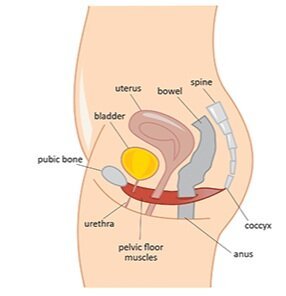What Is The Pelvic Floor?
What is the pelvic floor?
The pelvic floor muscles are made of three muscle layers that create a bowl inside your pelvis - this bowl is like a fruit bowl that supports the fruit. In this case, the fruit is the organs (your bladder, uterus, and rectum).
Where is the pelvic floor?
The pelvic floor muscles are located inside your pelvis muscles, underneath your organs- get it? the floor of the pelvis, pelvic floor! I’m funny, I know!
What Does the Pelvic Floor Do?
The pelvic floor has three primary functions:
-

Supporting The Organs
The pelvic floor muscles act like a sling, or hammock, to hold your organs inside of you. Social media teaches us to kegel, kegel, and do more kegels. But building a healthy pelvic floor is so much more than that! What if you are kegeling wrong?! What if the issue isn’t that your muscle is weak, but that your muscle is too tight and can’t move?! The analogy I give is to imagine a heavy weightlifter whose muscles are so tight, they can’t turn their neck from right to left. No bueno.
-

Bladder & Bowel Function
Normally, you have the urge to go to the bathroom, you hold it in, get to the toilet, sit, relax, and do your thing. Well, the pelvic floor muscles need to contract in a coordinated manner to allow for you to prevent leakage, and relax in a coordinated way for you to empty your bladder or bowels. If the timing of the muscles isn’t syncing correctly then you may end up with incontinence, urinary frequency, or bladder issues - but pelvic floor physical therapy can help!
-

Sexual Function
For women, the pelvic floor muscles need to stretch and accommodate for penile penetration. If you have trigger points, tightness, or scar tissue from tearing, or even tissues being delicate due to nursing or menopause; then sex is not going to feel great. Pelvic floor strength is linked to improved arousal and orgasm. For men, the pelvic floor muscles need to contract and relax repeatedly for sexual function. Trigger points, tightness or scar tissue can inhibit blood flow or inhibit your ability to get and maintain an erection.
Common causes of pelvic floor issues
Pregnancy: low load prolonged stretch can weaken these muscles or cause diastasis recti to develop
Vaginal delivery with or without vacuum/ forceps can damage these muscles
C-section can damage the abdominals which put extra strain on the pelvic floor muscles
Poor form when exercising- sometimes this can cause incorrect muscle patterns!
Abdominal/pelvic surgeries (like a sling, tummy tuck, laparoscopic excision, prostatectomy, hip/ back surgery, etc)
Menopause autoimmune issues, Ehlers-Danlos syndrome, other medical conditions
the list goes on . . . and sometimes it just happens!
Get started today.
Contact us to book a consultation and start improving your pelvic health today.



